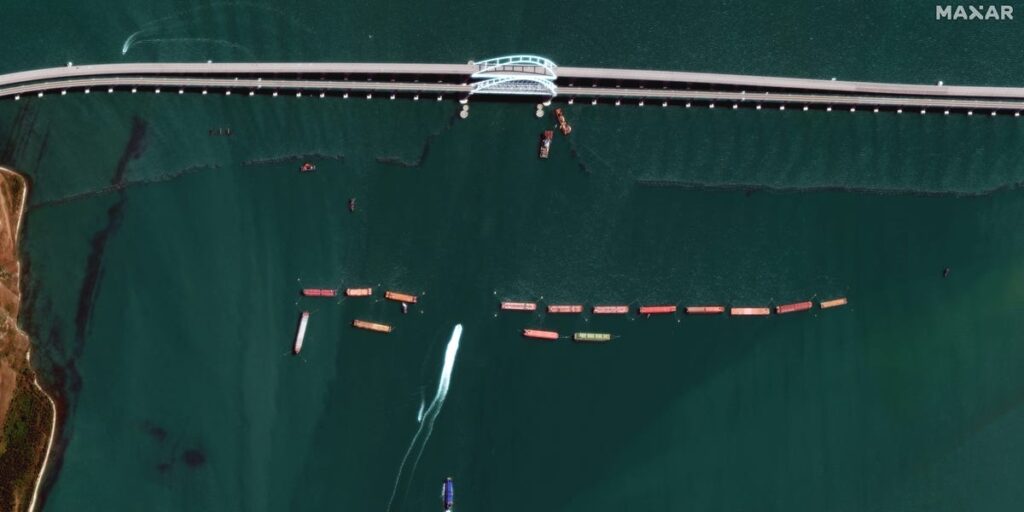Ukraine’s Resolve and Russia’s Defensive Measures for the Kerch Bridge
Ukraine has emphatically expressed its intent to destroy the strategic Kerch Bridge, a vital link between Russia and the occupied Crimean peninsula. This determination stems from the bridge’s significant role in sustaining Russia’s military and economic activities in Crimea. The Kerch Bridge, a prized accomplishment of Russian President Vladimir Putin, stands as a tangible symbol of the Kremlin’s enduring ambition to maintain its hold on Crimea.
In an effort to protect this strategic asset, Russia has deployed a series of defensive measures, including the placement of multiple barges and floating boom defenses around the bridge. Satellite images captured in late May show these defenses in place on the southern side of the 12-mile-long bridge, with additional images spotlighting the further expansion of these protective measures by early June.
The Russian Ministry of Defense confirmed that the placement of these barriers is an attempt to deter attacks from Ukraine’s advanced naval drones. These defenses aim to reduce the potential angles of approach these unmanned surface vehicles might take. However, it remains uncertain whether these measures will prove effective against the innovative and adaptive strategies employed by the Ukrainian forces.
Despite these efforts, previous defensive tactics, including smoke screens and the sinking of ships around the bridge, have proven largely ineffective against Ukraine’s persistent attacks. Ukraine has demonstrated considerable ingenuity in its naval drone program, continually adapting and innovating to circumvent Russian defenses. The naval drones, equipped with larger warheads and extended ranges, have already inflicted significant damage on Moscow’s Black Sea Fleet, resulting in the destruction of numerous warships.
Brady Africk, an open-source intelligence analyst and associate at the American Enterprise Institute, underscores this adaptability. According to Africk, while the newly installed barriers around the Kerch Bridge present new challenges, "These barriers complicate the equation, but it is still a solvable one.” Ukraine’s capacity to innovate past Russian defenses has been evident, as they continue to find effective means of striking targets within occupied territories.
In addition to the Kerch Bridge, Russia has also implemented similar defensive strategies around other critical sites, such as the ports of Sevastopol and Novorossiysk. This includes the deployment of additional barges, floating booms, and other cost-effective measures like smoke generators. These measures serve as an extra layer of protection over more expensive and labor-intensive methods, such as constant aerial patrols.
Russia’s approach to defending key assets, including upping the quantity of its defenses where quality falls short, is a pragmatic adaptation to a complex and evolving conflict. As Brady Africk notes, "In terms of constructing defenses and defending key assets, I think Russia has realized that where they can’t excel in quality of defenses, they should try and invest in quantity."
Ukraine’s persistent resolve to neutralize the Kerch Bridge, driven by both strategic and symbolic motivations, continues to challenge Russia’s defensive efforts. With each side adapting and counter-adapting, the future of this key infrastructure remains uncertain.
Source: Business Insider.
